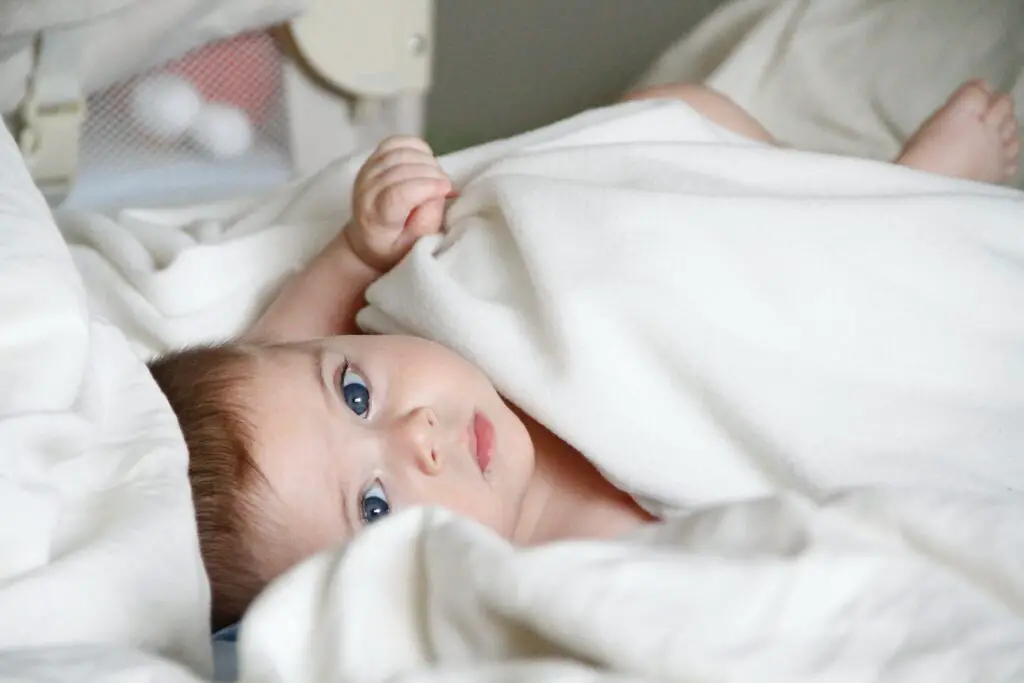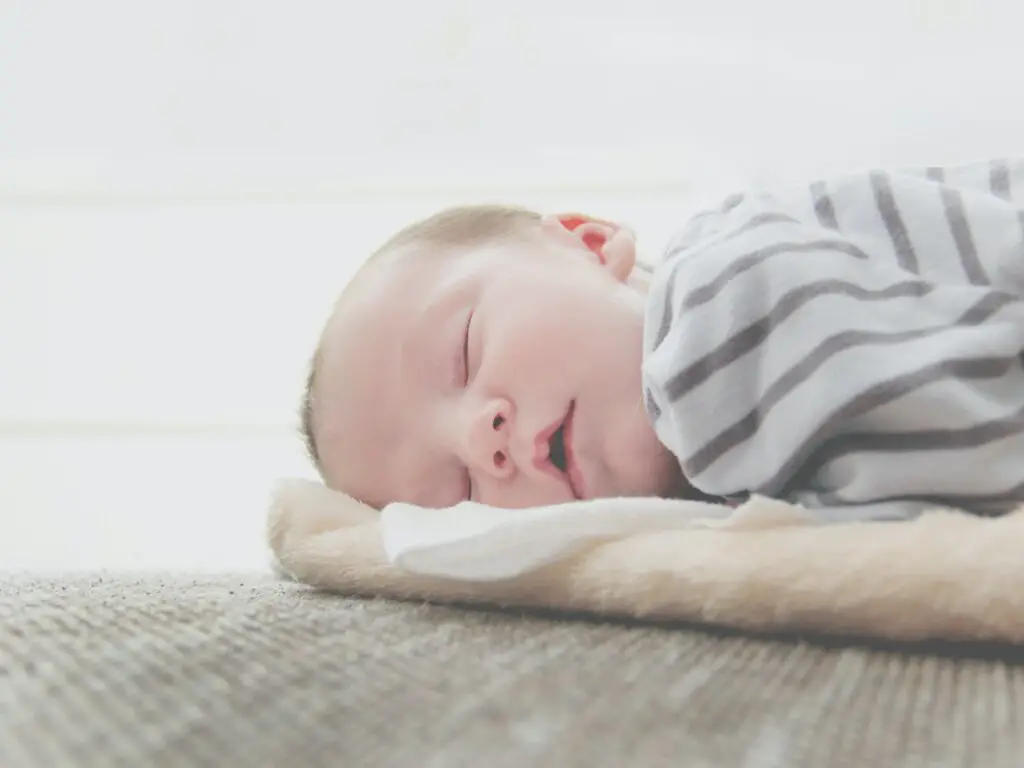Introduction to Baby Sleep Positions
Understanding your baby’s sleep positions is crucial for their safety and development. This article will delve into the importance of knowing these positions, the common ones, and how they can impact your baby’s well-being.
Importance of Understanding Baby Sleep Positions
Knowing how your baby sleeps is not just about ensuring they get a good night’s rest. It’s also about their safety. The American Academy of Pediatrics recommends that babies should sleep on their backs to reduce the risk of Sudden Infant Death Syndrome (SIDS). Understanding your baby’s sleep positions can also help you detect any unusual patterns or changes that may indicate a health issue.
Common Baby Sleep Positions
There are several common sleep positions that babies adopt. These include the back position, the side position, and the stomach position. However, it’s important to note that the safest position for a baby to sleep is on their back. This position reduces the risk of SIDS and helps your baby to have a safe and comfortable sleep.
How Baby Sleep Positions Affect Their Safety and Development
The position in which your baby sleeps can have a significant impact on their safety and development. For instance, sleeping on the back is known to reduce the risk of SIDS, while sleeping on the stomach can increase it. Furthermore, certain sleep positions can also affect a baby’s physical development. For example, prolonged time in one position can lead to a flat spot on your baby’s head, a condition known as plagiocephaly.
In conclusion, understanding your baby’s sleep positions is vital for their safety and development. Always ensure that your baby sleeps on their back, and monitor their sleep patterns regularly to detect any unusual changes. Remember, your baby’s health and well-being are paramount, and understanding their sleep positions is a step in the right direction.
Safe Sleep for Infants

Ensuring your baby’s safety during sleep is crucial. This section will provide you with the necessary guidelines, tips, and precautions to create a safe sleep environment for your infant.
-
Infant Sleep Guidelines
According to the American Academy of Pediatrics, infants should sleep on their backs, in a crib or bassinet with a firm mattress. Soft objects, loose bedding, or any objects that could increase the risk of entrapment, suffocation, or strangulation should be kept out of the baby’s sleep area. It’s also recommended that babies sleep in the same room as their parents for at least the first six months, or ideally, until their first birthday.
-
Creating a Safe Sleep Environment for Your Baby
Creating a safe sleep environment is essential for your baby’s health and well-being. Here are some tips:
- Use a firm sleep surface, such as a mattress in a safety-approved crib, covered by a fitted sheet.
- Do not use pillows, blankets, sheepskins, or crib bumpers anywhere in your baby’s sleep area.
- Keep soft objects, toys, and loose bedding out of your baby’s sleep area.
- Do not smoke or let anyone smoke around your baby.
-
Importance of Back Sleeping for Infants
Placing your baby on their back to sleep is the safest position. According to a study, back sleeping reduces the risk of Sudden Infant Death Syndrome (SIDS), the leading cause of death in infants aged one month to one year. It’s important to note that every sleep time counts, so you should always place your baby on their back to sleep, for naps and at night.

The Risks of Stomach Sleeping for Babies
As parents, it’s crucial to understand the potential risks associated with different sleeping positions for your baby. One such position that has been the subject of much debate and research is stomach sleeping. In this section, we will delve into why stomach sleeping is considered risky for babies, the health issues it can cause, and a case study linking it to Sudden Infant Death Syndrome (SIDS).
- Why is stomach sleeping considered risky for babies?Stomach sleeping is considered risky for babies due to the potential for suffocation. When a baby sleeps on their stomach, their mouth and nose can become blocked, making it difficult for them to breathe. This is especially dangerous for newborns and infants who cannot yet lift their heads or roll over independently. According to the American Academy of Pediatrics, babies sleeping on their stomachs have a higher risk of SIDS.
- Health issues associated with baby stomach sleepingAside from the increased risk of SIDS, stomach sleeping can lead to other health issues in babies. These include an increased risk of developing a flat spot on the back of the head, known as positional plagiocephaly, and a higher likelihood of experiencing gastroesophageal reflux disease (GERD). GERD can cause discomfort and lead to feeding problems in babies.
- Case study: Sudden Infant Death Syndrome (SIDS) and stomach sleepingA significant case study linking stomach sleeping to SIDS was conducted by the American Academy of Pediatrics. The study found that babies who sleep on their stomachs are at a higher risk of SIDS compared to those who sleep on their backs. This is believed to be due to the increased risk of suffocation and overheating when a baby sleeps on their stomach. As a result of this study, the ‘Back to Sleep’ campaign was launched, encouraging parents to put their babies to sleep on their backs to reduce the risk of SIDS.
In conclusion, while it may seem like a comfortable position, stomach sleeping poses significant risks for babies. As parents, it’s essential to be informed and take the necessary precautions to ensure your baby’s safety during sleep.
Understanding Baby Sleep Patterns
As parents, understanding your baby’s sleep patterns can be a challenging yet crucial part of nurturing. It’s essential to know that these patterns change as your baby grows and develops. Recognizing the signs that your baby is ready to change sleep positions and understanding their sleep cues can make this journey smoother. Let’s delve deeper into these aspects.
How baby sleep patterns change with age
During the first few weeks, babies sleep for most of the day, with periods of wakefulness lasting 1 to 3 hours. However, as they grow, their sleep patterns start to change. By the time they are six months old, most babies start to sleep for longer periods at night and have 2 to 3 naps during the day. By their first birthday, many babies sleep about 11 to 14 hours a day, including a couple of daytime naps.
Signs your baby is ready to change sleep positions
As your baby grows, they will start showing signs that they are ready to change sleep positions. These signs include being able to roll over on their own, lifting their head and chest when lying on their stomach, and pushing up on their arms. However, it’s important to remember that even if your baby shows these signs, you should always place them on their back to sleep until they are at least one year old to reduce the risk of Sudden Infant Death Syndrome (SIDS).
Key takeaways: Understanding your baby’s sleep cues
Understanding your baby’s sleep cues can help you establish a healthy sleep routine. These cues might include rubbing their eyes, yawning, looking away, fussing, and decreased activity. It’s crucial to put your baby to bed when they show these signs of tiredness rather than waiting until they are overtired.
In conclusion, understanding your baby’s sleep patterns, recognizing when they are ready to change sleep positions, and being aware of their sleep cues can significantly aid in ensuring a healthy sleep routine for your baby. Remember, every baby is unique, and what works for one might not work for another. Therefore, patience and observation are key in this journey.

When to Let Baby Sleep on Stomach
As your baby grows, they will begin to develop new sleeping habits. One of these may be the desire to sleep on their stomach. However, it’s essential to understand when it’s safe to let your baby sleep in this position.
Transitioning Baby to Stomach Sleeping
Transitioning your baby to stomach sleeping should be a gradual process that is carefully monitored. Here are some steps to consider:
Signs your baby is ready for stomach sleeping
Before you allow your baby to sleep on their stomach, it’s important to look out for signs that they are ready. This includes being able to roll over on their own, lift their head and chest when on their stomach, and move their head from side to side. These signs indicate that your baby has developed the necessary strength and coordination to sleep safely on their stomach.
Steps to safely transition your baby to stomach sleeping
Once your baby shows signs of readiness, you can begin the transition. Start by allowing your baby to have tummy time during the day under your supervision. This will help them get used to the position. Gradually increase the amount of time they spend on their stomach, always ensuring they are comfortable and safe. Remember, even if your baby is ready for stomach sleeping, it’s still recommended to place them on their back at bedtime and nap time for safety.
Monitoring your baby during this transition
During this transition, it’s crucial to monitor your baby closely. Use a baby monitor to keep an eye on them during sleep times. Check on them frequently to ensure they are breathing comfortably and are not showing any signs of distress. If you notice any problems, immediately return your baby to back sleeping and consult with your pediatrician.
Remember, every baby is unique and will develop at their own pace. Always consult with your pediatrician before making any significant changes to your baby’s sleep routine.
Baby Sleep Safety: Additional Tips
Ensuring your baby’s sleep safety goes beyond just their sleep position. It also involves creating a safe sleep environment and maintaining a consistent sleep schedule. Here are some additional tips to help you ensure your baby’s sleep safety:
Choosing the right crib and mattress for your baby
Choosing the right crib and mattress is crucial for your baby’s safety. The crib should have a firm mattress with a tight-fitting sheet. Avoid placing pillows, blankets, or stuffed animals in the crib as they can pose a suffocation risk. The crib should also meet all safety standards. For more information on crib safety standards, visit the Wikipedia page on Infant Bed Safety.
Safe swaddling practices
Swaddling can soothe a fussy baby and promote sleep. However, it’s important to swaddle safely. Make sure the swaddle is not too tight, which can cause hip problems. The baby’s face should be visible and not covered by the swaddle. Stop swaddling once your baby shows signs of rolling over.
Importance of regular sleep schedules
Establishing a regular sleep schedule is important for your baby’s health and development. Consistent sleep times and routines can help regulate your baby’s internal clock and ensure they get enough sleep. A regular sleep schedule can also make bedtime easier for both you and your baby.
Remember, every baby is unique and what works for one may not work for another. It’s important to observe your baby and adjust these tips as needed to best suit their needs. Always consult with a healthcare professional if you have any concerns about your baby’s sleep.
Conclusion: Ensuring Safe and Healthy Sleep for Your Baby
In this article, we’ve delved deep into the world of baby sleep positions, safety guidelines, and development. The goal has been to provide you with the knowledge and tools you need to ensure your baby has a safe and healthy sleep. Let’s recap what we’ve learned.
Recap of baby sleep positions and safety
There are three main sleep positions for babies: back, side, and stomach. The safest position, as recommended by the American Academy of Pediatrics, is the back position. This reduces the risk of SIDS (Sudden Infant Death Syndrome). Side and stomach positions are considered risky and should be avoided unless advised by a healthcare professional.
Importance of following infant sleep guidelines
Following infant sleep guidelines is crucial for your baby’s safety and health. These guidelines include placing your baby on their back to sleep, keeping the crib free of loose bedding and toys, and ensuring the baby sleeps on a firm surface. Adherence to these guidelines significantly reduces the risk of SIDS and other sleep-related infant deaths.
Final thoughts on baby sleep development and safety
Baby sleep development is a dynamic process that changes as your baby grows. Understanding these changes can help you create a safe and conducive sleep environment for your baby. Remember, every baby is unique and might not fit into the ‘typical’ sleep pattern. The key is to observe your baby’s sleep habits, follow the recommended guidelines, and consult with a healthcare professional if you have any concerns.
In conclusion, ensuring safe and healthy sleep for your baby is a responsibility that every parent must take seriously. It’s not just about getting your baby to sleep; it’s about creating a safe, comfortable, and conducive environment that promotes healthy sleep habits. By following the guidelines and recommendations we’ve discussed, you can rest assured knowing that you’re doing your best for your baby’s sleep health.














